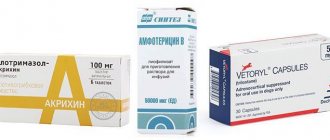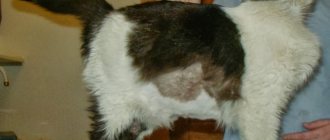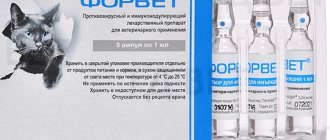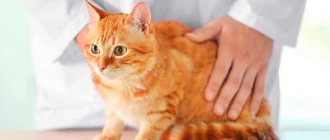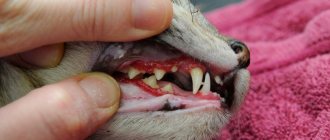Release form
"Etamzilat" is produced in the form of tablets and solution for injection. In tablet form, the product is produced in a dosage of 250 mg. One blister contains 10 tablets. Blisters are packed in cardboard containers of 5 or 10 units. The medicine can be purchased in 2 ml ampoules, which are placed in plastic containers (to prevent damage and breakage of glass) and packaged in cardboard consumer packaging, 10 units each.
Did you know? Due to a mutation in one of the key taste receptors, cats, unlike dogs, do not have a craving for sweets.
Tests to identify hidden causes
Once gastrointestinal bleeding in dogs and cats is suspected or confirmed, a search for an underlying cause should be undertaken: coagulation tests, complete blood count, routine chemistry profile, electrolytes, ACTH stimulation test, imaging (x-ray, ultrasound), endoscopy.
A coagulation test will help identify coagulopathies such as rodenticide poisoning or clotting factor deficiency. An increase in blood clotting time, which can be detected by testing, is not in itself the cause of gastrointestinal bleeding in cats and dogs, but can significantly aggravate the condition. The platelet count is important because a common cause of severe gastrointestinal bleeding in dogs is immune-mediated thrombocytopenia. An increase in hematocrit in patients with acute hemorrhagic and relatively normal protein concentrations is suggestive of hemorrhagic gastroenteritis.
Taking into account that the confirmed cause of ulceration of the gastrointestinal tract is liver and kidney diseases, special attention should be paid to the biochemical markers of these diseases (alkaline phosphatase, ALT, AST and bilirubin - for liver diseases; urea, creatinine, phosphorus - for kidney diseases). It is necessary to examine the level of electrolytes and perform an ACTH stimulation test, since the confirmed cause of GIB is hypoadrenocorticism. Research is carried out if no other causes of bleeding are found. A stool smear, culture, and test for parvovirus will confirm the suspicion of an infectious disease. Measuring gastrin levels is recommended if ulcers recur and do not respond to therapy.
Radiography will reveal foreign bodies, tumors, or free air in the peritoneal space. The cause of pneumoperitoneum can be assumed to be gastrointestinal perforation if the patient has not undergone abdominal surgery in the recent past. Although contrast radiography will reveal mucosal defects as the cause of gastrointestinal bleeding in cats and dogs, in most cases it can be replaced by ultrasound or endoscopic examination. Ultrasound can identify tumors and foreign objects accompanying gastrointestinal ulcers, if any. The use of ultrasound to recognize (define) ulcers is described. The study allows you to visualize the structure of the intestinal wall, its thickening, defects and craters. If serial testing is carried out (over time), it is possible to confirm changes that occur in response to therapy or the need for surgery in some cases. The use of ultrasound to identify ulcers in cats has also been described.
Endoscopy with greater accuracy (sensitivity) will allow you to determine the location of bleeding or ulcers in the upper gastrointestinal tract. Before the study, the patient's condition must be stabilized. The study often allows you to establish a diagnosis, assess the prognosis, can be therapeutically useful (removal of foreign bodies), and finally, during the study you can directly visualize the mucosa, obtain material for biopsy and culture, which may be necessary to determine damage or infection (for example, tumors, inflammatory bowel disease, protothecosis Disadvantages of endoscopy include the need for anesthesia, limitation to the proximal GI tract and colon, potential increased bleeding, and the possibility of iatrogenic ulceration.
If all of the above diagnostic methods do not allow us to establish the cause of ongoing gastrointestinal bleeding, then diagnostic laparotomy, scintiography with technetium-labeled erythrocytes and arteriography are performed. Using scintiography, you can determine the source of bleeding in dogs, and arteriography will allow you to establish vascular pathology of the gastrointestinal tract.
Pharmacological properties
The drug is used to stop and prevent bleeding of various etymologies. By influencing the first stage of hemostasis, which consists in the interaction of the endothelium and platelets, “Etamzilat” normalizes the condition of the capillary walls, which reduces their permeability.
Thanks to the drug’s effect on platelets, it is possible to significantly reduce blood loss, as well as reduce the risk of its occurrence. The peak concentration of the drug in the blood occurs 4 hours after administration; it is absorbed in the stomach and excreted from the body during urination during the day.
Find out the reasons why a cat pees blood.
Method of influence
Instructions for use of "Dicynon" for cats contain information that taking the drug helps improve blood clotting. The capillaries become stable and permeable, and mucopolysaccharides are successfully formed in them. In this way, it is possible to reduce the duration of bleeding and reduce the volume of blood loss.
An important feature of “Dicynon” for cats is its lack of ability to influence processes such as blood coagulation (clotting). The medication is not able to disrupt platelets or change the quality indicators of blood composition. How to give a pill to a cat, read on for tips on this.
Indications for use
At home, the medicine can be used for heavy bleeding due to extensive trauma, deep cuts, etc. It can be used for internal bleeding; it is also used during and after surgical interventions to reduce the risk of internal hemorrhage.
"Etamzilat" is prescribed to animals after surgery. The medication is prescribed after a heart attack or stroke - to strengthen the walls of blood vessels. Treatment with Etamzilat is prescribed for bleeding during urolithiasis. If there is blood in your pet's urine, your veterinarian may consider using a hemostatic agent necessary.
Introduction
Gastrointestinal bleeding in dogs and cats
is a significant cause of blood loss anemia and is a potentially life-threatening condition for dogs. Rarely described in cats. Bleeding can be acute, chronic, hidden (without visible blood), severe (with a large volume of bleeding, blood). It can be of moderate severity, stop on its own, or a severe, life-threatening condition. Significant bleeding can be detected by physical examination and history. However, you can ignore gastrointestinal bleeding if there are no signs indicating that the source of bleeding - the gastrointestinal tract or a concomitant disease hides this diagnosis. It is important to identify patients with gastrointestinal bleeding in dogs and cats as quickly as possible and initiate treatment to prevent worsening of the condition. This is because even moderate bleeding can progress to a life-threatening condition.
Instructions for use of the drug
For oral administration, a tablet form of the drug is used - it is prescribed 60 mg for every 5 kg of animal weight. Usually the tablets are given to the cat according to the following regimen: 60 mg - 2 times a day. The course of treatment is prescribed by a veterinarian, depending on the complexity of the disease, the duration of taking the drug can last up to 20 days.
For your pet to swallow the drug, you need to:
- Gently grab him by the withers and unclench his jaw.
- Place the tablet on the root of the tongue.
- Close your mouth and hold it with your hand.
- Blow into the cat's nose, provoking a swallowing reflex.
- Give the animal a drink of water.
Video: how to give a pill to a cat
The dosage in injections is calculated for each kilogram of the animal’s body weight (0.1 mg per 1 kg). Injections should be given 2 times a day, the duration of treatment should not exceed 4 days. If a person does not know how and where to inject, it is better to seek help from a specialist.
Important! If the cat has long hair, it is necessary to trim the area for the injection - this will avoid infection and administer the drug as correctly as possible.
To administer a drug intramuscularly to a cat, you will need the help of another person. Before carrying out the procedure, you need to prepare a syringe, alcohol, ampoule, as well as wash your hands and put on sterile gloves.
Instructions for administering the drug intramuscularly:
- The cat must be wrapped in a towel, leaving its head and lower body outside.
- The assistant must take the animal by the withers.
- The person giving the injection immobilizes the cat’s hind limbs with his left hand.
- Treat the area where the drug will be injected with alcohol.
- With your right hand you need to insert the needle 10 mm deep into the hip muscle. If no blood comes out, then the procedure can be continued.
- Insert the syringe into the needle and slowly inject the contents of the syringe into the body.
- Wipe the injection site with alcohol and cover with brilliant green.
Video: how to give an injection to a cat
Diagnostics
Bleeding in cats and dogs has been proven
when the source of bleeding is identified. In patients with signs of shock, during correction of the condition and search for hidden causes, a minimum number of emergency blood tests are performed, namely hematocrit, solids, blood nitrogen (BUN), glucose, if possible, pH, lactate and electrolytes. If hemoabdomen or septic peritonitis is suspected, emergency ultrasound, laparocentesis and diagnostic peritoneal lavage are indicated, which can be performed during the initial correction of the patient's condition. Once resuscitation has been initiated or the patient's condition has been stabilized, other diagnostic modalities should be considered.
Contraindications and side effects
The use of the medication is contraindicated in animals with thrombosis, as well as if anticoagulant therapy has been used over the past 3 months. The use of this medication by animals over 10 years of age, as well as by cats that are bearing kittens, is strictly prohibited.
Important! If an animal experiences symptoms of a drug overdose, you should immediately contact a specialist.
The drug is not recommended for animals with chronic kidney and liver diseases. Side effects when taking the medicine are extremely rare. But, if your pet has a tendency to allergic reactions, symptoms such as sneezing, tearing, and red eyes may appear.
Side effects if the correct dosage of Etamsylate is not observed can be:
- profuse vomiting;
- diarrhea;
- loss of orientation in space;
- refusal to eat;
- apathetic state;
- dyspnea;
- sunken eyeball.
Animals usually tolerate the drug well
Let's sum it up
"Dicinon" is a drug that is prescribed not only to people. It is also indicated for use in animals when there is a need to stop internal bleeding. Then there are two options: pills or injections.
The predominant substance in the composition of “Dicynon” is ethamsylate. This medicine belongs to drugs that are vital for people. Analogues of the drug can be found in the form of calcium chloride, aminocaproic acid, vikasol.
The drug is sold in pharmacies, but it is also used to treat animals. The shelf life of the medicine is no more than three years. It is strictly forbidden to use the medication if the expiration date has already expired. It should not be given not only to people, but also to animals. Expired medication can have negative consequences. Therefore, you must carefully monitor the date of manufacture of the medicine.
The use of Dicynon may have contraindications. They should be taken into account so as not to harm your pet. But in most cases, both the tablet drug and the injections are well tolerated by animals. With the help of "Dicynon" you can successfully restore the health of your tailed pet. Take care of your animals, consult a veterinarian in a timely manner so that your pet enjoys health and energy. Do not give medicine unless prescribed by a specialist!
Symptoms of the disease
When cystitis develops in a cat, the following phenomena may become symptoms of the pathology:
- Unusual pet behavior. A sick animal is anxious, often licks its belly and genitals, and meows loudly when going to the toilet. The cat becomes less playful; due to pain in the lower abdomen, he tries to move less and looks for a secluded place.
- Changes in the nature, intensity and frequency of urination. Due to spasms of the bladder, the animal begins to frequently go to the tray, and the amount of urine released decreases. Urine comes out in an uneven stream and in small portions, in the most severe cases - in drops. In the process of urinating, a sick cat arches its back, strains and strains, meowing loudly. Due to pain in the urethra, the animal may avoid the tray and urinate in places not intended for this.
- The presence of foreign impurities in urine. Due to the large number of leukocytes and epithelium, urine with cystitis becomes cloudy, and waste products of pathogenic microorganisms give it a sharp, unpleasant odor. In some cases, there may be traces of blood or pus in the discharge. The cause of the appearance of blood in the urine during cystitis can also be the presence of a primary disease - oncology or urolithiasis.
- Signs of intoxication. With a descending route of infection or a complication of cystitis with pyelonephritis, the cat’s body is poisoned by waste products of pathogens. Against the background of inflammation, lethargy, weakness of the animal, loss of appetite and interest in treats, diarrhea and periodic vomiting occur.
Analogs
Etamsylate (international name) belongs to the group of vital drugs, the price of which is regulated by health authorities. It can be included either in the composition of the drug dicynon or have the same name etamsylate (in accordance with the INN). Popular analogues include: vikasol, aminocaproic acid, calcium chloride, etc.
In the early stages, pregnant women can simultaneously be injected with Tranexam, which shows more pronounced effects:
- the drug begins to act much faster;
- it can also be taken by children while breastfeeding;
- quickly reduces the permeability of the vascular wall;
- tranexamic acid solution also costs significantly less;
- helps stop massive bleeding.
In turn, this drug has specific contraindications:
- poor compatibility with alcohol;
- not recommended for uterine fibroids;
- in case of threat of miscarriage.
- if storage conditions are violated.


